Nimbus. This is the grey ragged cloud which uniformly covers the sky. It is the true rain cloud, and an indication of low barometric pressure and rainy weather.
Storm Scud. This is formless masses of very low cloud driven fast before the wind. It is a sign of very low barometric pressure, and continuing bad weather.
CARRYING GEAR
The first thing in travel is the method of carrying your gear. The conventional pack or rucksack need not be described in this column, which concerns itself with improvisation, and therefore only those methods which call for no “shop-made” gear will be given.
THE SWAG
The swag, proverbial Australian means of carrying a heavy load, is one of the best methods in existence. It is simply made and very easily carried. It has the advantage of being extremely well balanced, two-thirds of the weight being carried behind the body, and about one-third in front. The result is that the carrier walks completely upright. Clothes, tent, bedding and the gear not wanted for the day’s walk are carried in the swag at the back, while the food and cooking utensils and day’s needs are in the “dilly” bag in front. Because of this the swag is not opened during the day but the dilly bag, attached to the front and right at your hand, is immediately accessible.
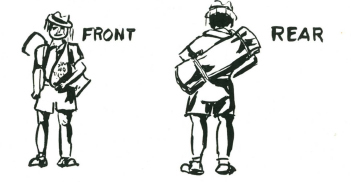
The only components for a swag are a swag strap, two binding straps and a dilly bag. The swag strap, preferably of soft leather, should be about two feet six inches long and a couple of inches wide; the two binding straps can be of any strong material such as rope, or a plaited cord, or a narrow leather strap. The dilly bag can be a sugar or flour bag, some two feet long, and twelve to fifteen inches wide.
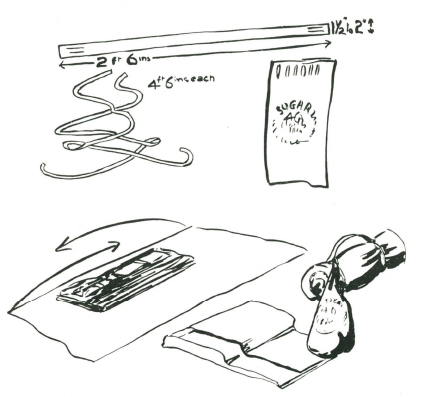
Laying out the gear for a swag, and rolling it and tying on the dilly bag.
These are the components for a swag. The swag strap should be soft and, if need arises, can be easily woven or plaited from strong grass, vines, bark strips or other material as indicated in Chapter 1. A soft leather strap is ideal.
Half the knack of carrying a swag consists in knowing how to “swing” it. Lay the roll, with the dilly bag extended in front of you, and then put the arm farthest away from the dilly bag through the swag strap. Heave the roll towards your back, and swing the body towards the swag, so that the dilly bag flies up and out. Duck the opposite shoulder, and catch the swinging dilly bag on it. The swag strap will then lie over one shoulder and the dilly bag over the other, with the swag roll carried at an angle across the back.

The alternative swag. Note the long strap and the position when the swag is “swung.” ‘
An alternative method of carrying the swag is to use two straps, one about 3 ft. 6 ins. long and the other about six ft. long. Both straps should be about an inch and a quarter wide and of strong soft material. The roll is made as for the swag, and the long strap is tied securely about five inches from one end of the roll. Five inches from the other end of the roll the other strap is fastened with the dilly bag held in position by the strap.
The swag is lifted to the left shoulder with the dilly bag in front and the roll at the back, the neck of the dilly bag hanging over the left shoulder. The long strap is passed on top of the right shoulder, and then under the armpit and around the back, and tied to a loop at the bottom corner of the dilly bag. This type of swag prevents the dilly bag from swaying’ and is preferred by some “bushmen,”
To roll the swag, lay your groundsheet or swag cover flat on the ground, and then fold your blankets to a width of about thirty inches by about fifteen to twenty. Spare clothes are laid lengthways on top, with your other gear. The sides of the groundsheet are folded in, and the whole is rolled from the blanket end to the free side, into a tight roll. If a tent is being taken this in turn is rolled in the tent. The two binding straps are laid six to eight inches from either end, that is 18 inches to 24 inches apart.
The two binding cords pass through the loops of the swag strap and are tied tightly about six to eight inches from either end of the roll. The food, cooking utensils, and daily needs are put in the dilly bag, and the neck of this is tied right at the junction of the binding strap with the swag strap, or alternatively a series of cuts in the neck of the bag can be made and the binding cord passed through these so that the bag is tight to the roll. If this is done it is a good idea to make a cut down the side of the bag for about twelve inches so that the contents can be taken out without removing the bag itself from the binding straps.
THE ADIRONDACK PACK
This is an easily improvised method of carrying heavy loads and an Adirondack pack can be made in less than half an hour. Select two light widely splayed hooks, with the arm of the hook 1 ft. 6 inches to 2 ft. long, and the shank portion three or tour feet in length. It is better to use dead wood, which is well seasoned. This is lighter. A number of short straight sticks are lashed to the inside edge of the shanks above the arms, and two straps are woven or plaited, and tied to the lower end of the shank and again about eighteen inches from the lower end. The two shanks should be about fifteen inches apart where the straps are at the upper end.
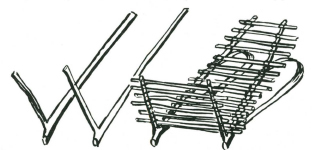
Showing an Adirondack pack, and how the load is carried high on the shoulders. If desired a head band can be used to steady the load.
PANNIER PACK
A pannier, eighteen inches square at the mouth, and two feet to two feet six inches deep, is woven from canes, rushes or any convenient pliable material. To this two straps woven from some pliable material are secured at the top, and eighteen inches below. The gear to be carried is loaded into the pannier.
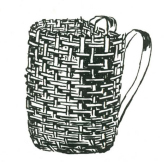
RIVER CROSSINGS
One of the principal hazards in cross-country travel are river crossings.
For the crossing of rivers, and if the walker is a swimmer, the pack can be wrapped in a groundsheet which has its corners and loose-folds tied together. This will support the traveller who holds the pack in his hands and by kicking with his legs he can cross safely with his pack. It is advisable to tie a short length of cord to the wrist so that if the pack slips from the hands it can be recovered.
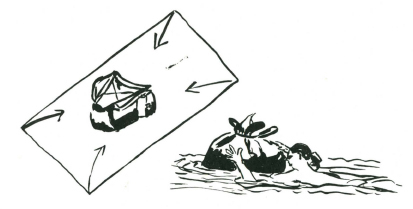
It is inadvisable to try to swim a river while wearing walking boots. These should be taken off and placed with the pack in the groundsheet. If a party of four or more are crossing, tie two or three packs together after each has been put in its groundsheet. One party stands by on the bank while the other party crosses.
Always place a layer of fern or grass or small brush beneath your pack before folding the groundsheet on it. If your groundsheet leaks slightly, this precaution will give your pack an inch or two clearance and keep it dry. With a frame rucksack, lay your frame uppermost–with a swag, place your swag roll and dilly bag side by side before folding the groundsheet.

A method of improvised water travel for poor swimmers or non-swimmers is by the use of two calico ration bags inflated, and used as water wings. These will easily support a human body in the water, and the non-swimmer can be taken across the river with absolute safety.